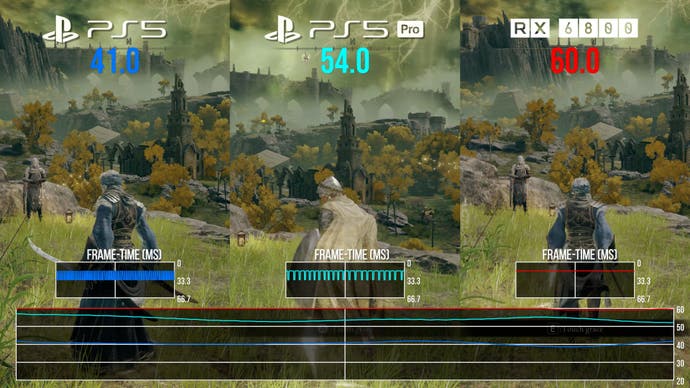Can PS5 Pro run Elden Ring at 60 frames per second?
No - but Game Boost still makes this the best console experience out there.
One of the most intriguing features of the PlayStation 5 Pro is complete compatibility with the existing library of PS5 titles - and the ability to run those games with the extra horsepower of the new hardware. So, in theory then, based on Sony's claims of an additional 45 percent of GPU performance, we should be in for a game-changing experience - games that don't hit their frame-rate targets should get there now - and there's one game renowned for its lacklustre technical quality: Elden Ring. Can the Pro fix the game where FromSoftware failed? The answer is almost, nearly, but not quite.
Let's review the quality modes offered by the game. There's a quality mode that targets native 4K resolution, while a performance alternative aims for 60fps using a dynamic resolution range between 1512p and native 4K (and there is some evidence to suggest that quality settings too may dynamically alter). Finally, there's an RT mode that requires the quality mode to be selected - but resolution is reduced to 1620p. For the resolution and performance hit, you get a relatively lacklustre implementation of ray-traced ambient occlusion and RT shadows.
In testing PS5 Pro's game boost, I started with the quality mode. With fixed settings and resolution in place, we can get performance differentials calculated using like-for-like content. We'd hope for the Pro to lock to 60fps, but if it does not, we can see the exact level of performance improvement you do get and in general, it varies according to context but is broadly in the 30 to 35 percent range. A lot of the game will run at 60fps, but it's hardly consistent and for the most part you're in the 50s - though truly challenging scenes can take you into the 40s. This is important as PS5's VRR support at 60Hz drops out at 48fps, so dips beneath this will look jarring - otherwise VRR saves the day in terms of game fluidity.
If the quality mode is struggling, it stands to reason that the performance mode with dynamic resolution scaling should perform a lot better - and it does, to a certain extent. Whether it's down to problems with the DRS system working with new hardware or else a CPU limitation, you still don't get a locked 60fps with a weird assortment of dropped frames - sometimes singular, sometimes clustered. However, the crucial point is that it's enough to keep you within the VRR window, so by default this becomes the best way to play Elden Ring on consoles.
The ray tracing mode? This is notorious for poor performance on the standard PS5 and even if the full 45 percent of extra performance was brought to bear, you'd still be nowhere near 60fps. Here, the results are strange overall. Sometimes it runs significantly better on Pro, while at other times, there's barely any difference at all. Without visibility into system load, we can only offer conjecture but the smart money would be on the extra CPU overhead ray tracing requires meaning that the Pro ping-pongs between CPU and GPU limitations. The ray tracing mode was poor on the standard PS5 and there's no joy with the Pro experience.
Does game boost tap into the additional RT capabilities of the PS5 Pro? On a PC, if you upgrade your GPU to one with superior RT performance, you'd expect to reap the benefits. However, based on our testing with Remedy's Control, there is a similar level of performance improvement to non-RT content - so typically around 30 to 33 percent of extra frame-rate. Consoles are quite different to PC, so while you get the extra grunt of the new hardware, you likely won't be able to tap into extra features without the developer working on a specific Pro patch update.
With that in mind, it'll be interesting to see if Elden Ring does receive bespoke support. On the one hand, FromSoftware has made little to no effort in improving the technical aspects of Elden Ring since launch, but on the other hand, it did deliver a (mediocre) update for Dark Souls 3 on PlayStation 4 Pro before supporting that console on all subsequent releases.


One final nugget on Game Boost - by checking out Cyberpunk 2077's cherry blossom marketplace, we can confirm that the feature doesn't just deploy the Pro's extra GPU horsepower. The CPU is faster in this mode too - but with around ten percent of extra clock, actual game performance improvements are in the single digit range. This certainly has an impact on Elden Ring's RT turnout on PS5 Pro and may also be holding us back from locking to 60fps elsewhere - it's difficult to tell.
From here, the question is whether Game Boost accurately represents the entirety of PS5 Pro's extra horsepower - or whether there are limitations that mean you don't see all of the GPU's additional capabilities. With that in mind, many commentators have compared the Pro's rasterisation performance to the RX 6800. Based on our Elden Ring tests with quality settings comparable to PS5 (and ramped slightly higher if there is no exact match with consoles), the 6800 is faster. This is just one test though: it require a good deal more research to get a firm handle on how performant the Pro really is.
We'll have more on Game Boost soon, but we've really enjoyed checking it out and the extra performance is clearly worthwhile - it seems to be especially potent for games that operate in the high frame-rate window with 120Hz support. There's more in our PS5 Pro review, but we aim to concentrate more on this feature across a wider range of games in an upcoming article.





.png?width=291&height=164&fit=crop&quality=80&format=jpg&auto=webp)

_MEGHzTK.png?width=291&height=164&fit=crop&quality=80&format=jpg&auto=webp)
.png?width=291&height=164&fit=crop&quality=80&format=jpg&auto=webp)

-Teaser-Trailer-(Directors-Cut)-_-Short-Film-2025-0-24-screenshot.png?width=291&height=164&fit=crop&quality=80&format=jpg&auto=webp)